|
 Hygrocybe julietae Hygrocybe julietae
SynonymsHygrophorus julietae
Hygrocybe insipida
BiostatusPresent in region - Indigenous. Endemic
Images (click to enlarge)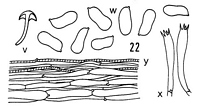
Caption: Hygrocybe insipida (Lange ex Lundell) Moser (= Hygrophorus julietae Stevenson, type) v. carpophores. - w. spores. - x. basidia. - y. cuticle | 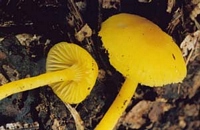
Caption: Hygrocybe julietae
Owner: Kaimai Bush | 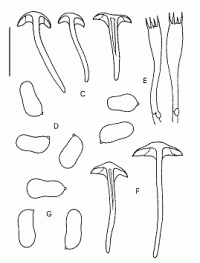
Caption: Fig. 11 Hygrocybe julietae (Stev.) Horak. (C-E: ZT 872): C.
basidiomes. D. spores. E. basidia. (ZT 999): F. basidiomes.
(K 697, type): G spores. | 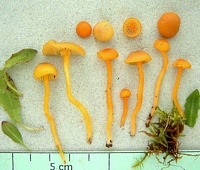
Owner: Karl Soop | 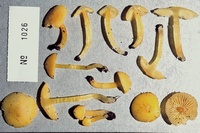
Caption: ZT1026
Owner: E. Horak: © Creative Commons Attribution-Noncommercial 3.0 New Zealand | 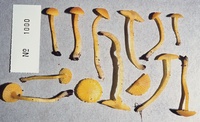
Caption: ZT1000
Owner: E. Horak: © Creative Commons Attribution-Noncommercial 3.0 New Zealand | 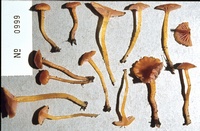
Caption: ZT0999
Owner: E. Horak: © Creative Commons Attribution-Noncommercial 3.0 New Zealand | 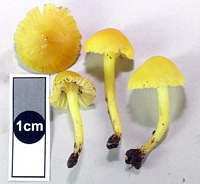
Owner: J.A. Cooper | 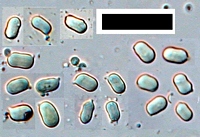
Caption: scale = 20um
Owner: J.A. Cooper | 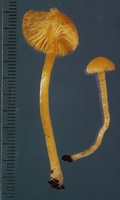
Caption: ZT1540
Owner: E. Horak: © Creative Commons Attribution-Noncommercial 3.0 New Zealand | 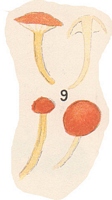 | 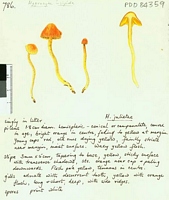
Caption: Watercolour
Owner: G.M. Taylor | 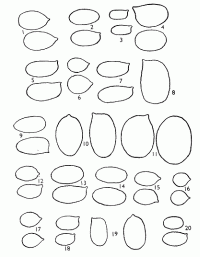
Caption: Spores X 2000 1. Hygrophorus salmonipes 2; H. elsae; 3, H .julietae; 4, H. variabilis; 5, H. lilaceo-lamelllatus; 6, H. muritaiensis; 7, H. keithgeorgei; 8, H. pseudococcineus; 9, H. rubro-carnosus; 10, H. miniceps; 11, H. procerus; 12, H. multic |
Article: Stevenson, G. (1963) [1962]. The Agaricales of New Zealand: IV. Kew Bulletin 16(3): 373–384.
Description: Pileus 0.5-1.1 cm., diam., orange, hemispherical to planoconvex,
matt to velvety-fibrillose; flesh luteous. Gills decurrent, creamy yellow to creamy white,
moderately distant with venose folds between, occasionally forked. Stipe 1-1.5
X 0.1-0.2 cm., luteous,
sometimes orange above, sometimes with white fibrils at the foot, equal or slightly
attenuated below, solid. Spores 6 X 3µm., oblong, hyaline. Basidia 30-40
X 5-6 μm., four-spored.
Habitat: habitat: in
soil under scrub, Wellington Botanic Garden, 1.7.19491 Juliet Cone.
Article: Horak, E. (1990). Monograph of the New Zealand Hygrophoraceae (Agaricales). New Zealand Journal of Botany 28(3): 255-306 (http://www.rsnz.org/publish/abstracts.php).
Description: Pileus-30 mm, hemispherical to convex or expanded, obtusely umbonate to subcampanulate;
orange, orange-yellow or brilliant yellow, red tints absent; distinctly viscid
when moist, glabrous to minutely velvety-fibrillose, hygrophanous, strongly
striate at margin. - Lamellae (8-) 10-20 (1 -5) decurrent to broadly emarginate-subdecurrent
(with short tooth), occasionally forked; pale yellow to yellow with faint orange
tint, edges concolorous, entire. - Stipe 10-50 x 1-2 (-3) mm, cylindrical, equal,
or subattenuated towards base; pale yellow to yellow, sometimes with orange
tint at apex, occasionally with white strigose or tomentose base; subviscid,
glabrous, solid becoming fistulose, single. - Context yellow, occasionally with
orange tint in pileus, whitish in base of stipe, brittle. - Odour and taste
not distinctive. - Chemical reactions on pileus: KOH - negative.
Spores 6-8 x 3-3.5 (-4) um, conspicuously constricted, peanut-shaped. - Basidia
25-35 x 5-6 um, 4-spored. - Cystidia absent. - Pileipellis an ixocutis of cylindrical,
interwoven, gelatinised hyphae (3-6 um diam.), with yellowish (KOH) plasmatic
and encrusting pigment, oleiferous hyphae present in subcutis; clamp connections
present (Pl. I, Fig. 7).
Habitat: ECOLOGY: Common; saprobic on soil among litter in Nothofagus, Leptospermum
scoparium and in broadleaved-conifer forests with tree ferns. May-July.
Distribution: DISTRIBUTION: NZ (NA, G, W).
Notes: In an earlier paper (Horak 1973: 147) this species was erroneously proposed
to be a synonym of the European H. insipida (Lange ex Lundell) which, however,
is distinguished by scarlet colours both on pileus and stipe.
Article: Horak, E. (1971). A contribution towards the revision of the Agaricales (Fungi) from New Zealand. New Zealand Journal of Botany 9(3): 403-462 (http://www.rsnz.org/publish/abstracts.php).
Notes: Hygrophorus julietae Stevenson (28 D) = Hygrocybe julietae (Stevenson) comb.
nov. (Basionym: H. julietae Stevenson, Kew Bull. 16: 377, 1962)
Article: Horak, E. (1973). Fungi Agaricini Novazelandiae I-V. Beihefte zur Nova Hedwigia 43: 200 p.
Description: ‘Pileus 5-11 mm diam., orange, hemispherical to plano-convex, matt to velvety-fibrillose; flesh luteous. Gills decurrent, creamy yellow to creamy white, moderately distant with venose folds between, occasionally forked. Stipe 10-15 x 1-2 mm, luteous, sometimes orange above, sometimes with white fibrils at the foot, equal or slightly attenuated below, solid'.
Spores 6-8 x 3-3.5 µm, ellipsoid, conspicuously constricted, smooth, inamyloid. Basidia 30-35 x 5 µm, 4-spored. Cystidia absent. Cuticle consisting of repent, slightly gelatinised hyphae (2-10 µm diam.) forming a cutis. Clamp connections present.
Habitat: In soil under scrub. New Zealand, Europe.
Notes: All micro- and macroscopic characters of the species described as H. julietae Stev. agree with H. insipida (Lange ex Lundell) which occurs in Europe on grassy places (see Lange 1940, P. 168 C). This fungus must be considered as an introduced species in New Zealand.
|